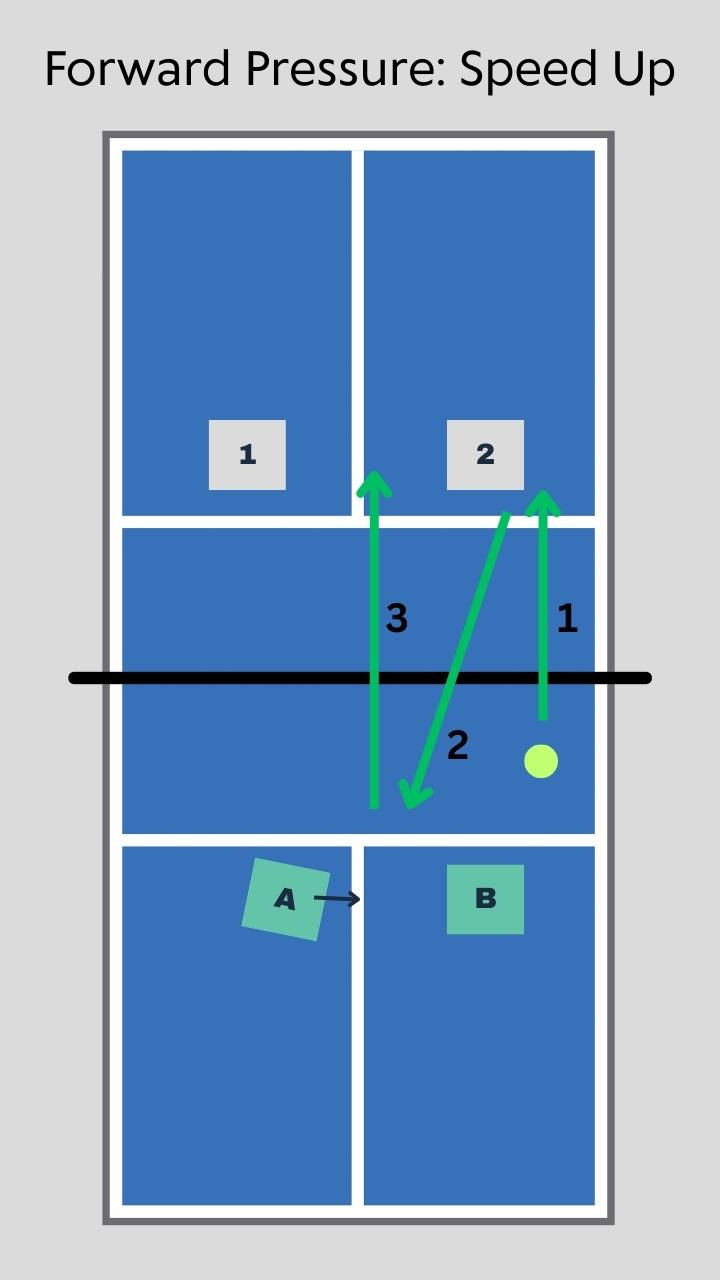What Type of Pressure Are You Dishing Out?
- Suzee Anderson

- Jul 23
- 4 min read
In pickleball, pressure is your best friend—when it’s applied strategically. But most players default to one kind: hitting hard and fast. The players who really dominate understand that there’s more than one way to make your opponents uncomfortable. The two key types? Forward Pressure and Lateral Pressure. Let’s break them down.
Forward Pressure: Speed, Power, and Pace
This is the type of pressure most players start with—drives, speed-ups, and aggressive volleys. It’s about hitting hard, forcing fast reactions, and trying to overpower your opponents. It absolutely has its place, especially when you catch someone off guard or out of position.

Example: Forward Pressure – Speed-Up Combo
You are Player B and receive a dink that is attackable in the outside quadrant of the court.
A great speed-up combo is to speed up down the line at Opponent 2’s backhand (shot #1). The counter will likely float back toward the middle (shot #2). Partner A shifts, steps in, and looks to finish the point with a counter up the middle (shot #3).
This type of combo is a classic forward pressure pattern: applying pace, forcing a weak return, and finishing decisively.
But here’s the thing: In today’s game, players are getting better at handling pace. If all you bring is power, your attacks can become predictable. You may even find yourself giving your opponents exactly what they want—some players love pace and will use your power against you.
So yes, forward pressure can score points—but only if it’s used at the right time and set up correctly.
Lateral Pressure: Make Them Move
Lateral pressure is more subtle but just as deadly. It’s about moving your opponents, forcing them to lean, stretch, recover, and reposition: a precise dink to an open spot, a targeted dink to a weak side, a lob that pulls them off the line. These shots don’t need to be fast—they just need to be smart.

Example: Lateral Pressure – Crosscourt Dink (“Ankle Breaker”)
You are Player B and receive a dink that’s attackable.
You notice Opponent 1 has shifted to face you and stepped over to close the middle. Your instinct might be to speed up straight ahead—but instead, look across the net. There’s a big open space crosscourt and behind Opponent 1.
A soft crosscourt roll or push dink into that space creates immediate pressure. Your opponent will be scrambling, likely popping the ball up or missing it entirely. That’s what we call an ankle breaker.
Lateral pressure creates space, messes with balance, and opens the door for forward pressure to shine. If you’ve pulled someone out wide or off-balance, that’s when your next speed-up or put-away becomes much more effective.
Think of it like chess. You’re not just hitting shots—you’re setting traps.

Example: Lateral Pressure – Offensive Lob
You’re Player B and receive an attackable dink in front of you.
Both opponents look ready for a speed-up, staying low and compressed at the kitchen. Instead of playing to their expectation, go up and over with an offensive lob—ideally crosscourt over Opponent 1 or over Opponent 2’s backhand side.
Crosscourt gives you more depth and a higher margin for error. Even if it’s not a winner, it flips the script and resets your court positioning. And throwing in this shot occasionally—even if they’re not compressed—adds variety and unpredictability to your game.
How Do I Choose the Right Kind of Pressure?
The key to applying the right kind of pressure is awareness. You need to read the court, your opponents, and the patterns developing during the match. Here’s how to dial in your decision-making:
Step 1: Read the Clues
Before choosing how to attack, take a split second to see what the court is giving you. Ask yourself:
Is an opponent leaning or reaching and off-balance?
Are the opponents recovering from a wide shot and leaving space open?
Are they vulnerable to a lob due to court position or body positioning?
These cues often point to lateral pressure opportunities—a dink behind movement, a push into space, or a lob over compressed players.
On the other hand, if your opponent is off-balance or gave you a floater in the middle of the court, that may be your green light for forward pressure—bringing pace into a spot they can’t defend well or to jam them up.
Step 2: Evaluate What’s Working
Don’t fall into the trap of using the same tactic over and over. Instead, constantly gather feedback during the match. Ask:
Are my speed-ups earning points, or are they getting countered?
Are opponents struggling to reset or defend when I move them laterally?
Are we creating chaos or just feeding their strengths?
If what you’re doing isn’t producing pressure, adjust the recipe. Maybe your drives and speed-ups aren’t making your opponents uncomfortable, but they are late to set up or recover from a dink or a drop. That’s your cue to lean into precision and court movement over pace.
Step 3: Keep Them Guessing
Pressure isn’t just power. It’s about keeping your opponents guessing, off-balance, and reacting instead of dictating. Mix in both forward and lateral pressure. Be observant. Be strategic. And most important, be willing to adjust.
Because at the end of the day, the best pressure is the kind your opponent didn’t see coming. •
Watch in-action video examples of how to apply pressure like a pro—see the shots, feel the strategy at suzeeandersonacademy.com/pressure.

Suzee Anderson
PPR Coach Developer
Club Pickleball USA
Suzee Anderson Academy





Comments